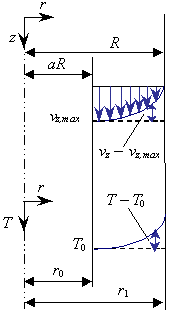Heat Transfer Problem :
Radial temperature distribution in annular chemical reactor
Problem.
An annular chemical reactor consists of a packed bed of catalyst between two coaxial cylinders. The inner and outer cylinders have radii of r0 and r1, respectively. It is reasonable to assume that there is no heat transfer through the surface of the inner cylinder, which is at a constant temperature T0. The catalytic reaction releases heat at a uniform volumetric rate S throughout the reactor, whose effective thermal conductivity k may be considered constant. Neglect the temperature gradients in the axial direction.
a) Derive a second-order differential equation to describe the radial temperature distribution in the annular reactor starting with a shell thermal energy balance.
b) Establish the radial temperature distribution by solving the differential equation.
c) What viscous flow problem is analogous to this heat conduction problem?
d) Derive an expression for the volumetric average temperature in the reactor.
e) Develop an expression for the temperature at the outer cylindrical wall of the reactor. What will be the outer wall temperature if both the inner and outer radii are tripled?
Solution.
a)
From a thermal energy balance over a thin cylindrical shell of thickness ![]() r in the annular reactor, we get
r in the annular reactor, we get
At steady-state, the accumulation term will be zero. So,
| (1) |
where S is the rate of generation of heat by chemical reaction per unit volume and qr is the heat flux in the radial direction.
Dividing by 2![]()
![]() r L and taking the limit as
r L and taking the limit as ![]() r tends to zero,
r tends to zero,
| (2) |
| (3) |
Since the effective thermal conductivity k of the reactor bed may be considered constant, on substituting Fourier's law (![]() ) we get
) we get
| (4) |
